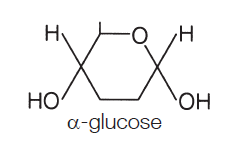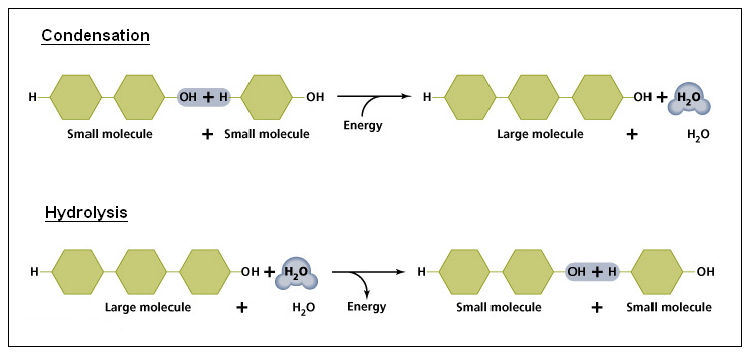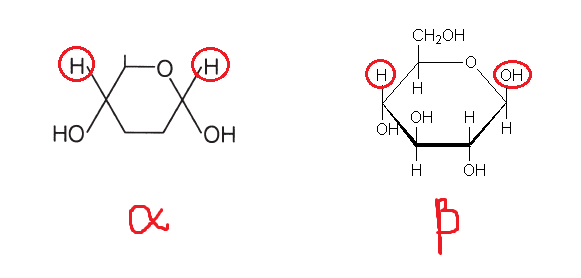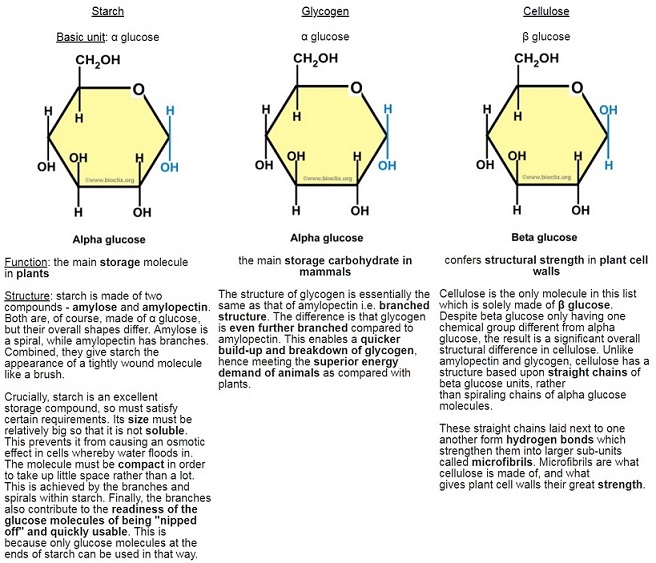Carbohydrates as well as proteins are polymers and contain only a few different types of atom. In the case of carbohydrates, the basic molecular units are called monosaccharides – these are the monomers. (mono = single; poly = multiple; saccharide = sugar)
α (alpha) glucose is one of three important monosaccharides to learn, as you need to be able to draw it:

Glucose is a key carbohydrate in biology because it is the preferred fuel that provides energy during cellular respiration as well as the building block for complex polysaccharides and other compounds that use it such as glycoproteins. As a monomer, it is small and water soluble and thus accessible to cells for respiration. Plants and other organisms can create it through photosynthesis. It can be built into starch or glycogen and stored away for later use. When required, it can be obtained by breaking starch or glycogen down again. This is what maintains blood sugar levels.
The points where the lines intersect each symbolise a carbon (C) atom. You need not show those. The figure above is taken from the specification itself, so take it as a good guide. So the monosaccharide alpha glucose (commonly, just glucose) somehow becomes a polysaccharide, This is achieved by condensation reactions, and the bonds formed are called glycosidic bonds.
You should be able to draw this. The resulting molecule, maltose, is a disaccharide (two monomers). If you keep adding glucose molecules to the chain, you get… *drum roll please* …starch. Starch is made up of multiple (very many indeed) monomers, so it is a polymer i.e. it is made of multiple monosaccharides, so it is a polysaccharide.
The reverse reaction of breaking it down into monomers is hydrolysis.

Two other important carbohydrates are beta glucose and ribose. Alpha glucose is more specifically a hexose because it has 6 carbon atoms in its structure. Beta glucose is also a hexose. Ribose on the other hand is a pentose and as you’ll later find out, a key constituent of DNA.

So glucose, whether alpha or beta, is a hexose with 6 carbon atoms. Ribose is a pentose with 5 carbon atoms.
The difference between alpha and beta glucose is quite subtle.

Alpha glucose is what’s termed in chemistry a cis isomer while beta glucose is a trans isomer. Cis because the hydrogen (top, H) and hydroxyl (bottom OH) groups on the left and right of the glucose are on the same side of each other, and for beta glucose it’s trans because they are across from each other diagonally, and not on the same side.
Potatoes anyone?
You also need to know about two other disaccharides and their constituent monosaccharides – sucrose and lactose.
Sucrose is made of glucose and fructose.
Lactose is made of glucose and galactose.
It’s easy enough to remember: they’re both made of glucose, and lactose (MILK) is also made of galactose (galaxy – Milky Way). Both sucrose and lactose are formed similarly by the condensation of their monosaccharides.

